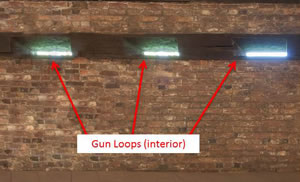The term blockhouse is most likely derived from the German word blochaus which means “a house which blocks a pass.” Blockhouses were almost entirely an American innovation as they were mainly used on the frontier as a way to defend European settlers from Native American Indian attacks. While blockhouses were commonly stand-alone structures used by settlers for defense and/or shelter, they could also be found as part of larger fortifications. Similar to redoubts, blockhouses could take many different shapes and be constructed out of many different materials. To use the words of historian Brian Leigh Dunnigan, “a blockhouse was not necessarily a redoubt, [but] it could serve the purposes of one.” While it is no question that the Fort Pitt Block House was originally called and built as a redoubt for Fort Pitt, its appearance was so similar to a traditional blockhouse that it officially became named as such by the end of the nineteenth century. (Brian Leigh Dunnigan, Forts within a Fort: Niagara’s Redoubts, pages 5-8.)
What is a Gun Loop?

This image shows the gun loops of the Block House as viewed from outside of the structure. Note how there are ranges of gun loops on both floors of the building. Photo credit – Fort Pitt Society
This image shows the gun loops of the Block House as viewed from outside of the structure. Note how there are ranges of gun loops on both floors of the building. Photo credit – Fort Pitt Society
The wooden gun loops surrounding the Block House, both upstairs and downstairs, are made entirely out of white oak, each set being hand hewn. These gun loops, or loopholes, were the holes through which soldiers could look for enemies, as well as where they could fire their weapons in the event of an attack. Loopholes were common for 18th century defensive structures like redoubts and blockhouses, and the use of such openings had been in place since the Middle Ages in Europe.

This image depicts how the gun loops appear inside the Block House. They have a wider opening inside to allow for range of motion with a musket. Photo credit – Fort Pitt Society
The loops in the Block House were built specifically for musket fire, and therefore no cannons or larger artillery were used in the structure. Each opening was cut at a different angle to provide the best defense possible for the structure. On the interior the openings were wide and tall to allow for a better range of motion with the soldiers’ muskets, but they tapered downward so the exterior of the openings was less wide and much smaller. This made it difficult for enemy fire to reach into the building. There were originally twenty-two openings in each set of gun loops, including ten smaller openings at each corner of the building, both upstairs and downstairs. Because of changes to the Block House over time, some of the gun loops have been obliterated by restoration and repair or, in the case of one loophole, by a new doorway. With all of that being said, sixty percent of the gun loops in the Block House are original from 1764, making them an important feature to the structure today.
What is a Redoubt?
The term redoubt is derived from Medieval Latin as a “secret place,” although by the 18th century it was a word used to define a specific type of military structure used as part of larger fortifications. Redoubts were mostly built in North America throughout the 17th, 18th and 19th centuries. They could be placed close to a fort’s walls or placed in the outer defense works of a fort. They could also be constructed even further away from the fort and its outer works. No matter where a redoubt was built, however, the main purpose was always clear: redoubts could serve as a first line of defense in the face of enemy fire or invasion. There was not any uniform way in which to build redoubts, and therefore they tended to be of various shapes, constructions and appearances. According to historian Brian Leigh Dunnigan, redoubts were “any small, self-contained fortification without flanking devices such as bastions…from small, square, round or polygonal forts to the familiar log blockhouse of the American frontier when the latter stood alone and was not part of a larger fort.” The Fort Pitt Block House – and presumably the other redoubts of Fort Pitt – was different from more traditional redoubts in that it had a roof, therefore making it seem more like a blockhouse. (Brian Leigh Dunnigan, Forts within a Fort: Niagara’s Redoubts, pages 5-8.)


